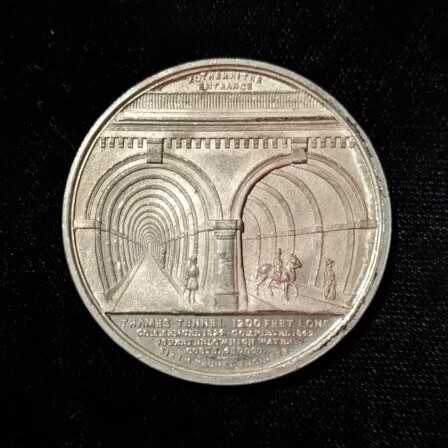This medal is typical of 19th-century mass-produced medals, one of at least 30 variant Thames Tunnel medals, produced in an array of sizes with different combinations of images. Thames Tunnel medals were produced in a range of materials, including examples of Tunnel ‘medals’ struck in clay from the Thames, while a small number were struck in gold for select individuals such as the Duke of Wellington and Earl Spencer. The vast majority, however, were struck in bronze or, as here, in white metal, a silver-coloured alloy of tin. These medals could be bought in the Tunnel itself. Adverts for similar white metal medals on sale in the Tunnel show prices ranged from as much as 2s./- to as little as 3d. for the smallest variants. Bronze versions were far more costly, with prices as high as 7s./6d.
The earliest portrait medals were produced for aristocratic patrons in 15th-century Italy, and were modelled explicitly on classical coinage. Such medals largely portrayed contemporary rulers or figures from classical antiquity, and were made of cast metal. By the 18th century, most portrait medals were struck rather than cast, a simpler, faster and more uniform process. The early 19th century then saw a revival of older techniques associated especially with Pierre-Jean David d’Angers (1788-1856) in France, who produced a portrait medal of Marc Brunel in 1828. This revival was arguably also assisted by a concurrent Renaissance revival across Europe. By the 1840s, the entrance of large quantities of medals to national collections (such as the medal collection of King George III bequeathed to the British Museum) reified their transformation from objects of aristocratic curiosity to artistic works of historical importance.
Between the 16th and 18th centuries, the range of individuals portrayed as well as the styles of depiction diversified. Several 19th-century innovations then accelerated this expansion significantly, as medals became mass-market items on sale to a broader public. The 1836 invention of white metal enabled ‘silver’ medals to be produced much more cheaply, while the invention of the electrotype process and the reducing machine around the same time enabled faster mass production. Queen Victoria underlined this rapid progress in a diary entry detailing her visit to the Great Exhibition in 1851:
‘We likewise saw medals, made by machinery, which not more than 15 years ago were made by hand! 50 million instead of one million can be supplied a week now.’
Renaissance medals tend exclusively to present profile portraits, in a style derived from classical portraiture known as all’antica. Whilst in the 19th century, portrait medals began more often to use three-quarter profiles, or front-on portraits, this portrait of Brunel is of the earlier, all’antica type. It is perhaps intended to complement and emphasise the almost neo-classical architectural depiction of the Tunnel’s entrance presented on the reverse. By contrast, the text of a medal (known as an exergue) was traditionally written in Latin. The use of English on this medal instead underlines the connection of the sitter and subject with contemporary Britain, while also indicating a less aristocratic market was targeted by its creators.
In earlier periods, portrait medals were often pierced with a hole, or had a loop attached, in order to be hung from walls or worn on the body. By the 1800s most medals were kept flat in specially designed cabinets. They served notably as conversational stimuli for wealthy men, who discussed and debated their artistic qualities and the achievements of the (often male) individual portrayed, in a process which contributed to developing and strengthening gendered social norms. The emergence of mass-production techniques to some extent expanded this aristocratic pursuit, enabling the new middle classes to emulate such activities.
Given their portability and ever-decreasing retail price, medals offered a convenient method of self-promotion, acting as a form of ‘social media’ for the individual portrayed. This is the case of this medal, which provides an image of Brunel, an image of the Tunnel, and brief information about the Tunnel’s construction. In that sense, this medal is linked to other mass-produced portraits of Brunel in the Brunel Museum’s collection (such as LDBRU:2001.1 and LDBRU:2003.1) as well as to various printed ephemera advertising the Tunnel itself. Together, such objects increased Brunel’s public profile, linking his work as an engineer to his physical image, whilst advertising the Tunnel as a visitor’s attraction. In modern terms, we might interpret this medal as part of Brunel’s ‘public relations strategy’, notably following the well-publicised series of incidents and setbacks which affected the Tunnel’s construction.
Text (obverse): Sir Isambart Marc Brunel F.R.S. & c.
Text (reverse): 76 FT Below High Water Mark Commenced March 1825 Opened March 25 1843 Cost £416,000
To find out more about this medal, take a look at this video of Jake and Ismael, who completed a work experience programme at the Museum in July 2024:

